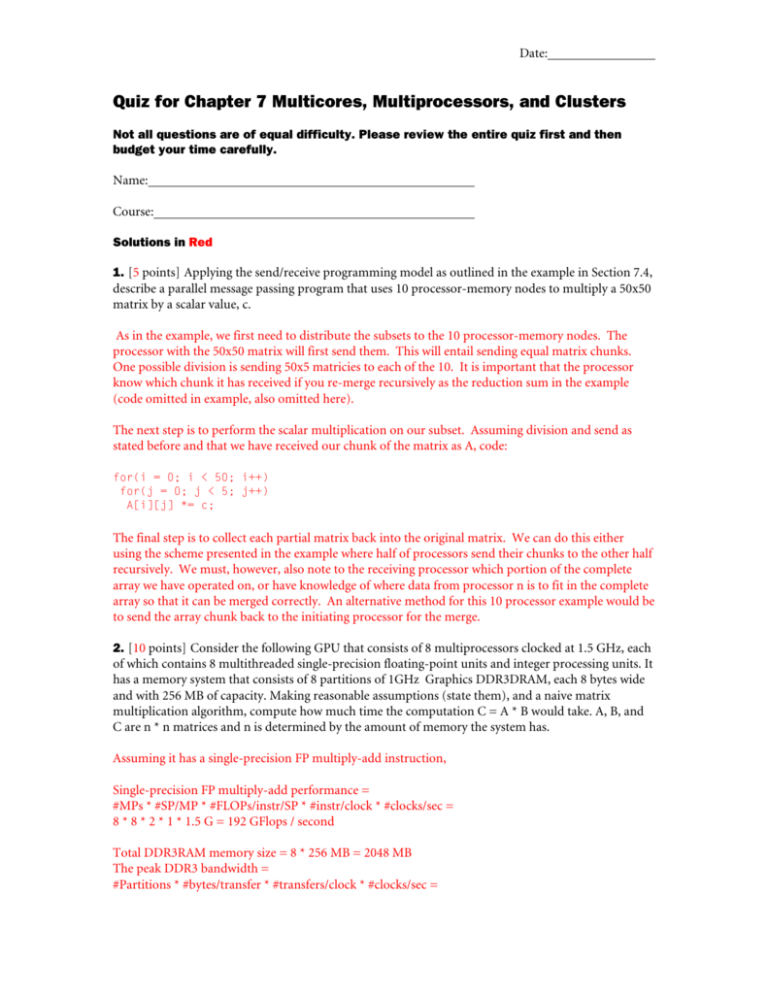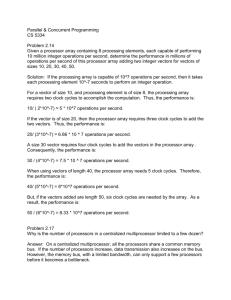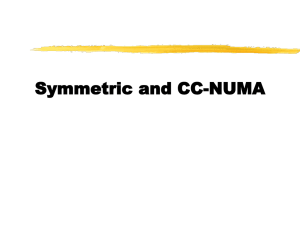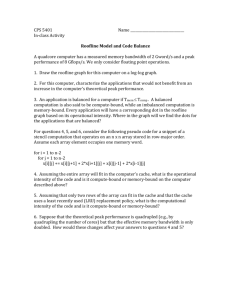Quiz for Chapter 7 Multicores, Multiprocessors, and Clusters3.10
advertisement

Date:
Quiz for Chapter 7 Multicores, Multiprocessors, and Clusters
3.10
Not all questions are of equal difficulty. Please review the entire quiz first and then
budget your time carefully.
Name:
Course:
Solutions in Red
1. [5 points] Applying the send/receive programming model as outlined in the example in Section 7.4,
describe a parallel message passing program that uses 10 processor-memory nodes to multiply a 50x50
matrix by a scalar value, c.
As in the example, we first need to distribute the subsets to the 10 processor-memory nodes. The
processor with the 50x50 matrix will first send them. This will entail sending equal matrix chunks.
One possible division is sending 50x5 matricies to each of the 10. It is important that the processor
know which chunk it has received if you re-merge recursively as the reduction sum in the example
(code omitted in example, also omitted here).
The next step is to perform the scalar multiplication on our subset. Assuming division and send as
stated before and that we have received our chunk of the matrix as A, code:
for(i = 0; i < 50; i++)
for(j = 0; j < 5; j++)
A[i][j] *= c;
The final step is to collect each partial matrix back into the original matrix. We can do this either
using the scheme presented in the example where half of processors send their chunks to the other half
recursively. We must, however, also note to the receiving processor which portion of the complete
array we have operated on, or have knowledge of where data from processor n is to fit in the complete
array so that it can be merged correctly. An alternative method for this 10 processor example would be
to send the array chunk back to the initiating processor for the merge.
2. [10 points] Consider the following GPU that consists of 8 multiprocessors clocked at 1.5 GHz, each
of which contains 8 multithreaded single-precision floating-point units and integer processing units. It
has a memory system that consists of 8 partitions of 1GHz Graphics DDR3DRAM, each 8 bytes wide
and with 256 MB of capacity. Making reasonable assumptions (state them), and a naive matrix
multiplication algorithm, compute how much time the computation C = A * B would take. A, B, and
C are n * n matrices and n is determined by the amount of memory the system has.
Assuming it has a single-precision FP multiply-add instruction,
Single-precision FP multiply-add performance =
#MPs * #SP/MP * #FLOPs/instr/SP * #instr/clock * #clocks/sec =
8 * 8 * 2 * 1 * 1.5 G = 192 GFlops / second
Total DDR3RAM memory size = 8 * 256 MB = 2048 MB
The peak DDR3 bandwidth =
#Partitions * #bytes/transfer * #transfers/clock * #clocks/sec =
Name: _____________________
8 * 8 * 2 * 1G = 128 GB/sec
Modern computers have 32-bit single precision
So, if we want 3 n*n SP matrices, maximum n is
3n^2 * 4 <= 2048 * 1024 * 1024
nmax = 13377 = n
The number of operations that a naive mm algorithm (triply nested loop)
needs is calculated as follows:
For each element of the result, we need n multiply-adds
For each row of the result, we need n * n multiply-adds
For the entire result matrix, we need n * n * n multiply-adds
Thus, 2393 GFlops.
Assuming no cache, we have loading of 2 matrices and storing of 1 to the graphics memory. That is 3 *
n^2 = 512 GB of data.
This process will take 512 / 128 = 4 seconds
Also, the processing will take 2393 / 192 = 12.46 seconds
Thus the entire matrix multiplication will take 16.46 seconds.
3. [5 points] Besides network bandwidth and bisection bandwidth, two other properties sometimes
used to describe network typologies are the diameter and the nodal degree. The diameter of a network
is defined as the longest minimal path possible, examining all pairs of nodes. The nodal degree is the
number of links connecting to each node. If the bandwidth of each link in a network is B, find the
diameter, nodal degree, network bandwidth, and bisection bandwidth for the 2D grid and n-cube tree
shown in Figure 7.9.
2D grid/mesh:
Diameter: = = 4
Nodal degree: 4
Network Bandwidth: 2*P*B = 2*16*B = 32*B
Bisection Bandwidth: 2**B = 2**B = 8*B
n-cube tree (n=3):
Diameter: 3*2/2 = 3
Nodal degree: 2*n = 2*3 = 6
Network Bandwidth: 12*B
Bisection Bandwidth: 2* * B= 8*B
Quiz for Chapter 7 Multicores, Multiprocessors, and Clusters
Page 2 of 8
Name: _____________________
4. [5 points] Vector architecture exploits the data-level parallelism to achieve significant speedup. For
programmers, it is usually be make the problem/data bigger. For instance, programmers ten years ago
might want to model a map with a 1000 x 1000 single-precision floating-point array, but may now
want to do this with a 5000 x 5000 double-precision floating-point array. Obviously, there is abundant
data-level parallelism to explore. Give some reasons why computer architecture do not intend to create
a super-big vector machine (in terms of the number and the length of vector registers) to take
advantage of this opportunity?
Some of the possible reasons include the hardware cost (of course), the addressing space for
instructions, the load/store time for super-big vectors, the memory bandwidth, the handling of page
faults.
5. [5 points] Why should there be stride-access for vector load instruction? Give an example when this
feature is especially useful.
Imagine there were an array of objects, and the i-th word in each object corresponded with some field
in the object. Next, suppose your program performs some simple operation over all objects in the
array, such as adding a constant to the i-th field of each object. The stride-access for vector load allows
you to do this easily.
6. [10 points] A two-part question.
(a) What are the advantages and disadvantages of fine-grained multithreading, coarse-grained
multithreading, and simultaneous multithreading?
Fine-grained multithreading can hide the throughput losses arises from both short and long stalls. But
it will slow down the execution of individual threads, especially those without stalls.
Coarse-grained multithreading only switches when there is a long stall, so it is less likely to slow down
the execution of individual threads. However, it has limited ability to overcome throughput losses due
to short stalls and relatively higher startup overhead.
Simultaneous multithreading dynamically issue operations from multiple threads simultaneously. This
covers the throughput losses from both short and long stalls, and does not suffer from high switching
overhead. But SMT may still slow down the execution of individual threads if that thread does not
have any stall.
(b) Given the following instruction sequence of three threads, how many clock cycles will fine-grained
multithreading, coarse-grained multithreading use respectively? Annotations are the same as in Figure
7.5
Thread 1:
[] [] []
[] [] []
[] []
[]
[] [] []
(stall)
(stall)
[] []
[]
Quiz for Chapter 7 Multicores, Multiprocessors, and Clusters
Page 3 of 8
Name: _____________________
(stall)
[] [] []
Thread 2:
[] []
[] [] []
(stall)
[] [] []
[]
[]
[] []
(stall)
[]
[]
Thread 3:
[]
[] []
[] [] []
(stall)
[] []
[]
[] [] []
[] [] []
[]
[]
Fine-grained: 22 cycles
Coarse-grained: execute T1 first, hits the stalls, switch to T2, then T3. Total clock cycles are: 26 cycles
SMT: 14 cycles
7. [10 points] Consider a multi-core processor with 64 cores where first shared cache is at level L3 (L1
and L2 are private to each core). Suppose an application needs to compute the sum of all the nodes in
a perfectly balanced binary tree T (A tree where every node has either two or zero children and all the
leaves are at the same depth/level). Assuming that an add operation takes 10 units of time, the total
sum can be computed sequentially, in time 10*n units, ignoring the time to load and traverse links in
the tree (assume they are factored in the add). Here n is the number of nodes in T. One way to
compute the sum in a parallel manner is to have two arrays of length 64: (a) an input array having the
roots of 64 leaf subtrees (b) an output array that holds the partial sums computed for the 64 leaf
subtrees for each core. Both the arrays are indexed by the id (0 to 63) of the core that is responsible for
that entry. Furthermore, assume the following:
•
•
•
The input arrays are already filled in with the roots of the leaf subtrees and are in the L1
caches of each core.
Core 0 is responsible for handling the internal nodes that are not a part of any of the 64
subtrees. It is also responsible for computing the final sum once the partial sums are filled in.
Every time a partial sum is filled in the output array by a core, another core can fill in its
partial sum only after a minimum delay of 50 units (due to cache invalidations).
In order to achieve a speedup of greater than 2 (over sequential code), what is the minimum number
of nodes that should be present in the tree?
Quiz for Chapter 7 Multicores, Multiprocessors, and Clusters
Page 4 of 8
Name: _____________________
Let n be the total number of nodes in the tree.
Amount of time taken to run the code sequentially = 10*n
1
2
4
5
Time taken to sum up the internal nodes = (1 + 2 + 2 + 2 + 2 )*10 = 63*10 = 630
Time taken to sum up all the 64 partial sums = 64*10 = 640
Time spent in cache invalidations = 50*63 = 3150
Time each of the 64 processor spend in adding their share of nodes = [(n – 63)/64]*10
Speedup = (10*n)/(630 + 640 + 3150 + ([(n – 63)/64]*10))
For this to be >= 2, the value of n should be at least 911 elements
8. [10 points] Consider a multi-core processor with heterogeneous cores: A, B, C and D where core B
runs twice as fast as A, core C runs three times as fast as A and cores C and A run at the same speed (ie
have the same processor frequency, micro architecture etc). Suppose an application needs to compute
the square of each element in an array of 256 elements. Consider the following two divisions of labor:
(a)
Core A
Core B
Core C
Core D
32 elements
128 elements
64 elements
32 elements
Core A
Core B
Core C
Core D
48 elements
128 elements
80 elements
Unused
(b)
Compute (1) the total execution time taken in the two cases and (2) cumulative processor utilization
(Amount of total time the processors are not idle divided by the total execution time). For case (b), if
you do not consider Core D in cumulative processor utilization (assuming we have another
application to run on Core D), how would it change? Ignore cache effects by assuming that a perfect
prefetcher is in operation.
(1) Total execution Time
(a) Total execution time = max(32/1, 128/2, 64/3, 32/1) = 64 (unit time)
(b) Total execution time = max(48/1, 128/2, 80/3, 0/1) = 64 (unit time)
(2) Utilization:
(a) Utilization = (32/1 + 128/2 + 64/3 +32/1) / 4 * (1/64) = 0.58
(b) Utilization = (48/1 + 128/2 + 80/3 + 0/1) / 4 * (1/64) = 0.54
(b) Utilization (if processor D is ignored) = (48/1 + 128/2 + 80/3) / 3 * (1/64) = 0.54
Quiz for Chapter 7 Multicores, Multiprocessors, and Clusters
Page 5 of 8
Name: _____________________
9. [10 points] Consider a system with two multiprocessors with the following configurations:
(a) Machine 1, a NUMA machine with two processors, each with local memory of 512 MB with local
memory access latency of 20 cycles per word and remote memory access latency of 60 cycles per word.
(b) Machine 2, a UMA machine with two processors, with a shared memory of 1GB with access latency
of 40 cycles per word.
Suppose an application has two threads running on the two processors, each of them need to access an
entire array of 4096 words, is it possible to partition this array on the local memories of the NUMA
machine so that the application runs faster on it rather than the UMA machine? If so, specify the
partitioning. If not, by how many more cycles should the UMA memory latency be worsened for a
partitioning on the NUMA machine to enable a faster run than the UMA machine? Assume that the
memory operations dominate the execution time.
Suppose we have x words on one processor and (T-x) words on the other processor,
where T = 4096.
Execution Time on the NUMA machine = max(20x + 60(T-x), 60x + 20(T-x))
= max(60T-40x, 20T+40x)
The max is 40T (unit time), where x = T/2
Execution Time on the UMA machine = 40T
So, we can't make the NUMA machine faster than the UMA machine. However, if the UMA access is
one more cycle slower (that is, 41 cycles access latency), the NUMA machine could be faster.
10. [10 points] Consider the following code that adds two matrices A and B and stores the result in a
matrix C:
for (i= 0 to 15) {
for (j= 0 to 63) {
C[i][j] = A[i][j] + B[i][j];
}
}
If we had a quad-core multiprocessor, where the elements of the matrices A, B, C are stored in row
major order, which one of the following two parallelizations is better and why ? What about when they
are stored in column major order ?
(a) For each Pk in {0, 1, 2, 3}:
for (i= 0 to 15) {
for (j= Pk*15 + Pk to (Pk+1)*15 + Pk)
{
// Inner Loop Parallelization
C[i][j] = A[i][j] + B[i][j];
}
}
(b) For each Pk in {0, 1, 2, 3}:
Quiz for Chapter 7 Multicores, Multiprocessors, and Clusters
Page 6 of 8
Name: _____________________
for (i= Pk*3 + Pk to (Pk+1)*3 + Pk) {
// Outer Loop Parallelization
for (j= 0 to 63) {
C[i][j] = A[i][j] + B[i][j];
}
}
When they are stored in row major order, Parallelization (a) is better because by accessing the
elements row by row, a thread can take advantage of the spatial locality property of caches. On the
other hand, by accessing elements column-wise, there are more likely to be more cache misses as
elements in a column are separated by a certain number of columns = row size (in memory and
therefore in a cache line). When elements are stored in a column-major order, Parallelization (b) is
better.
11. [10 points] How would you rewrite the following sequential code so that it can be run as two
parallel threads on a dual-core processor ? Try to balance the loads as much as possible between the
two threads:
int A[80], B[80], C[80], D[80];
for (i = 0 to 40)
{
A[i] = B[i] * D[2*i];
C[i] = C[i] + B[2*i];
D[i] = 2*B[2*i];
A[i+40] = C[2*i] + B[i];
}
The code can be written into two threads as follows:
Thread 1:
int A[80], B[80], C[80], D[80];
for (i = 0 to 40)
{
A[i] = B[i] * D[2*i];
C[i] = C[i] + B[2*i];
A[i+40] = C[2*i] + B[i];
}
Thread 2:
int A[80], B[80], C[80], D[80];
for (i = 0 to 40)
{
D[i] = 2*B[2*i];
}
12. [10 points] Suppose we have a dual core chip multiprocessor with two level cache hierarchy: Both
the cores have their own private first level cache (L1) while they share their second level cache (L2).
The first level cache on both the cores is 2-way set associative with cache line size of 2K bytes, and
access latency of 30ns per word, while the shared cache is direct mapped with cache line size of 4K
bytes and access latency of 80ns per word. Consider a process with two threads running on these cores
as follows (assume the size of an integer to be 4 bytes which is same as the word size):
Quiz for Chapter 7 Multicores, Multiprocessors, and Clusters
Page 7 of 8
Name: _____________________
Thread 1:
int A[1024];
for (i=0; i < 1024; i++)
{
A[i] = A[i] + 1;
}
Thread 2:
int B[1024];
for (i=0; i< 1024; i++)
{
B[i] = B[i] + 1;
}
Initially assume that both the arrays A and B are in main memory, whose access latency is 200ns per
word. Assume that an int is word sized. Furthermore, assume that A and B when mapped to L2 start at
address 0 of a cache line. Assume a write back policy for both L1 and L2 caches.
(a) If the main memory blocks having arrays A and B map to different L2 cache lines, how much time
would it take the process to complete its execution in the worst case? (Assuming this is the only
process running on the machine.)
The first time A[0] and B[0] is accessed, they miss the L1 & L2 cache and go to main memory. After
that the first 512 entries are accessed via the L1 cache. Then there is an L1 miss and then the rest are
accessed through the L1 cache again.
Total time for accessing array A = 200 + 2*30*511 + 80 + 2*30*511 = 61600
Total time for accessing array B is also the same since they both map to different L2 cache lines and the
L1 cache is private.
In the worst case the threads 1 and 2 could execute sequentially in which case, the total time for
execution of the process = 2*61800 = 123200 cycles
(b) If the main memory blocks having arrays A and B map to the same L2 cache line, how much time
would it take the process to complete its execution in the worst case? (Assuming this is the only
process running on the machine.)
In the worst case, thread 1 could access A[0], thread 2 could access B[0], then thread 1 could access
A[1] followed by B[1] access by thread 2 and so on. Every time A[I] or B[i] is accessed, it evicts the
other array from L2 cache and so a subsequent access to the other array has to again cause a main
memory access.
Worst Case Execution for the Process = 2*200*1024 = 409600 cycles, a factor of 6 slowdown over the
sequential code.
Quiz for Chapter 7 Multicores, Multiprocessors, and Clusters
Page 8 of 8







